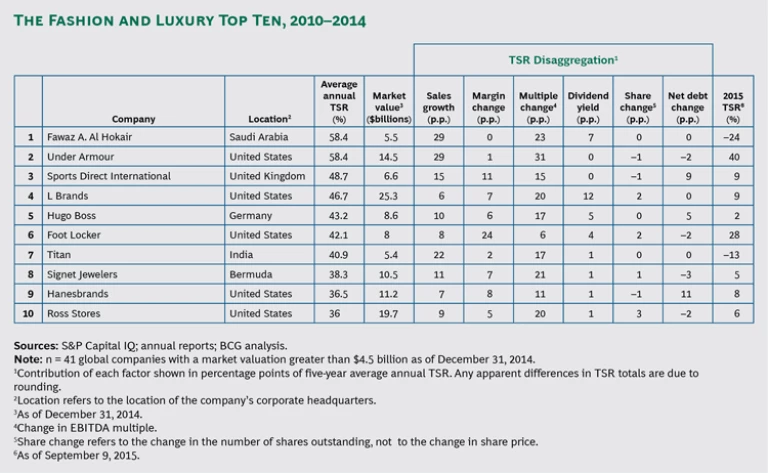Over the past five years, the global fashion and luxury sector has delivered extremely strong value creation, thanks to rising incomes in many emerging markets and a recovering global economy.
In 2015, The Boston Consulting Group conducted its annual study of the total shareholder return
The Drivers of TSR
Most of the top-performing companies were able to create value primarily through sales growth and improved valuation multiples, with smaller contributions from improved margin performance. (See the exhibit, “The Fashion and Luxury Top Ten, 2010–2014.”) For example, Under Armour, which tied with Fawaz A. Al Hokair for first place, generated 29 percentage points of TSR from sales growth and 31 percentage points from changes to its multiple, with little or no contribution from any other levers. Under Armour is also notable in that it is one of four companies to make a repeat appearance on the top ten list, along with Sports Direct International (which finished third), L Brands (fourth), and Hugo Boss (fifth).
Turbulence in China
As in prior years, the top performers in the sector were primarily mass-apparel companies, rather than high-fashion labels. That is partly due to flattening growth in emerging markets—particularly in China. During the past decade, as that country’s wealthier population increased in size and affluence, many fashion companies were able to grow significantly by opening new stores in the region. Yet when growth in China slowed and consumption rates eased in 2014, the revenues for those companies plateaued as well. Businesses are now trying to drive growth by improving same-store sales rather than opening new stores.
In addition, frugality and anticorruption reforms in China have hurt specific segments in the fashion and luxury industry. Gift-giving practices among private companies have slowed, and the custom of sending even small gifts to government officials or employees of state-owned enterprises for the Chinese New Year or the Midautumn Festival has largely vanished. What’s more, the use of public funds for any purchase is now heavily scrutinized. This shift has directly affected the sales of luxury products—particularly watches, small leather goods, and business attire, all of which had been commonly purchased as gifts or perks.
We believe that, in the long term, the economic shift in China represents a necessary correction rather than a more profound crash. The country still holds tremendous potential for fashion and luxury companies, provided that they can withstand some turbulence as the current correction unfolds. In the near term, one bright spot from the correction is that midlevel fashion and accessory brands—accessible luxury players, such as Coach and Michael Kors, along with “fast fashion” players, such as Zara and H&M—may benefit. The smaller indulgences that these companies offer are more moderately priced and thus more within reach of a wider segment of the Chinese population. In addition, a growing interest in health and wellness will lead to growth opportunities for sports and outdoor companies.
Digital Opportunities
We believe that digital represents a foundational shift in the way fashion and luxury goods are sold, and that it will serve as a means to drive value creation for the foreseeable future in two ways. The first is through e-commerce. Digital sales represent a major opportunity, particularly for high-end fashion companies. In the past several years, many such companies have resisted rolling out e-commerce sites on the grounds that buying goods online is not a true luxury experience. But increasingly, convenience is the ultimate luxury. The challenge is to create a differentiated experience for consumers.
One potential solution for many high-end fashion companies is to augment their online offerings with designer profiles, photo essays, videos, and other content that captures the rich heritage underlying their products. Another solution is to create differentiated offerings through exclusivity. Restricting access to confirmed customers—or those who are likely to make a high-end purchase—can change the way consumers experience a website or perceive a mobile offering. That said, finding the right balance between exclusivity and inaccessibility is tricky, and many companies will struggle to achieve it.
In addition, most high-end companies need to close the gap with mass retailers in terms of omnichannel execution. Increasingly, the ability to purchase, pick up, and return goods through any channel—whether online or off—is becoming a baseline requirement. Some fashion brands have taken steps to improve their omnichannel execution, but they must continue to build on that progress. More accessible luxury companies, such as Coach and Tory Burch, generate a much higher percentage of their sales through e-commerce than their competitors do and can serve as models for this approach.
The second opportunity offered by digital is the use of analytics and data to develop a more detailed picture of customers in order to better meet their future needs. We expect that more high-fashion and luxury brands will use data and analytics to inform key decisions along the value chain. For example, in company-owned stores, customer data can be used to revamp assortment planning and merchandising on a regional basis. For online sales, companies can use data to tailor more relevant, personalized marketing offers.
Sports Direct International (third in our TSR ranking) is an example of a brick-and-click company that has managed to transform its business model and adopt a truly omnichannel approach. The company has grown by acquiring retailers and brands, such as Everlast and Slazenger, and by strengthening its own labels. But it also experienced a boost in online sales recently after introducing quick online check-out solutions, such as click-and-collect, as well as websites for its customers in European countries. Currently, Sports Direct is doubling the size of its warehouse in the UK in order to serve online customers more effectively.
Fashion is always in flux, and markets expand and contract, but the basics of value creation do not change. Companies that can balance strong growth with attractive margins, employ digital, and meet their customers’ needs will generate steady, reliable returns for their investors.









